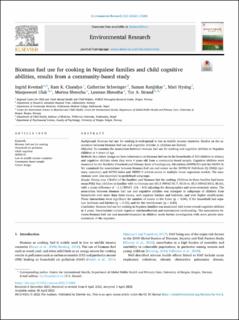| dc.contributor.author | Kvestad, Ingrid | |
| dc.contributor.author | Chandyo, Ram Krishna | |
| dc.contributor.author | Schwinger, Catherine | |
| dc.contributor.author | Ranjitkar, Suman | |
| dc.contributor.author | Hysing, Mari | |
| dc.contributor.author | Chandyo, Manjeswori Ulak | |
| dc.contributor.author | Shrestha, Merina | |
| dc.contributor.author | Shrestha, Laxman P. | |
| dc.contributor.author | Strand, Tor Arne | |
| dc.date.accessioned | 2022-12-28T11:39:10Z | |
| dc.date.available | 2022-12-28T11:39:10Z | |
| dc.date.created | 2022-05-06T07:24:09Z | |
| dc.date.issued | 2022 | |
| dc.identifier.issn | 0013-9351 | |
| dc.identifier.uri | https://hdl.handle.net/11250/3039630 | |
| dc.description.abstract | Background Biomass fuel use for cooking is widespread in low to middle income countries. Studies on the association between biomass fuel use and cognitive abilities in children are limited. Objective To examine the association between biomass fuel use for cooking and cognitive abilities in Nepalese children at 4 years of age. Methods In a cohort design we have information on biomass fuel use in the households of 533 children in infancy and cognitive abilities when they were 4 years old from a community-based sample. Cognitive abilities were measured by the Wechsler Preschool and Primary Scale of Intelligence, 4th edition (WPPSI-IV) and the NEPSY-II. We examined the associations between biomass fuel use and scores on the WPPSI-IV Full-Scale IQ (FSIQ) (primary outcome), and WPPSI index and NEPSY-II subtest scores in multiple linear regression models. The associations were also examined in predefined subgroups. Results Ninety-nine (18.6%) of the families used biomass fuel for cooking. Children in these families had lower mean FSIQ than children in families with no biomass use (83.3 (95%CI 81.7, 85.0) vs. 85.3 (95%CI 84.5, 86.0)), with a mean difference of −2.2 (95%CI -3.9, −0.5) adjusting for demographics and socio-economic status. The association between biomass fuel use and cognitive abilities was strongest in subgroups of children from households with more than three rooms, with separate kitchen and bedroom, and with higher wealth-score. These interactions were significant for number of rooms in the home (p = 0.04), if the household had separate bedroom and kitchen (p = 0.05), and for the wealth-score (p = 0.03). Conclusion Biomass fuel use for cooking in Nepalese families was associated with lower overall cognitive abilities at 4 years. Uncertainties include exposure misclassification and unmeasured confounding. The associations between biomass fuel use and neurodevelopment in children needs further investigation with more precise measurements of the exposure. | en_US |
| dc.language.iso | eng | en_US |
| dc.publisher | Elsevier | en_US |
| dc.rights | Navngivelse 4.0 Internasjonal | * |
| dc.rights.uri | http://creativecommons.org/licenses/by/4.0/deed.no | * |
| dc.title | Biomass fuel use for cooking in Nepalese families and child cognitive abilities, results from a community-based study | en_US |
| dc.type | Journal article | en_US |
| dc.type | Peer reviewed | en_US |
| dc.description.version | publishedVersion | en_US |
| dc.rights.holder | Copyright 2022 The Author(s) | en_US |
| dc.source.articlenumber | 113265 | en_US |
| cristin.ispublished | true | |
| cristin.fulltext | original | |
| cristin.qualitycode | 2 | |
| dc.identifier.doi | 10.1016/j.envres.2022.113265 | |
| dc.identifier.cristin | 2021953 | |
| dc.source.journal | Environmental Research | en_US |
| dc.relation.project | Norges forskningsråd: 223269 | en_US |
| dc.identifier.citation | Environmental Research. 2022, 212 (Part C), 113265. | en_US |
| dc.source.volume | 212 | en_US |
| dc.source.issue | Part C | en_US |

